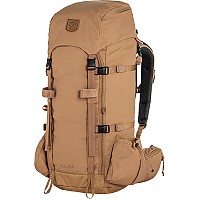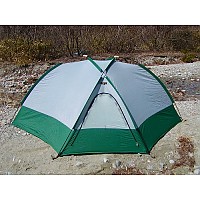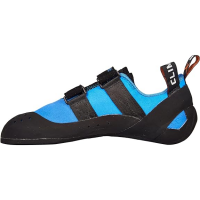
No frills, high quality, tough, reliable trekking poles, which have helped preserve my aging knees over the last twenty years of outdoor buffoonery.
Pros
- Well constructed
- High quality materials
- Smooth, reliable adjustment
- Confidence-inspiring grip
- Durable
- Dependable
Cons
- Not light, by modern standards
- Grips could be comfier
- No bells, whistles, or Bluetooth connectivity
As one of life's reluctant innovators...bordering on the Luddite...I had been moaning for a while about my creaky leg hinges, when a younger buddy asked why I hadn't bought some poles?
Twenty years ago, if you saw a hiker with poles in Scotland you assumed she was a skier or, at least, a Swiss holidaymaker. Of course, before I could engage such a person in conversation she had disappeared into the clouds at a pace I couldn't match.
Lekis were in the local shop, so Lekis I bought, in 2000. Too much money to be an impulse buy—but the knees were insistent. Long downhill hikes had become painful, especially if I was carrying more than a day sack, or if the terrain was the kind of broken rock which slides out from under you without warning. (Everywhere in Britain, in fact.)
I hadn't given much thought to the extra uphill impetus and efficiency that poles would provide. My first visit to the local hills involved eight hours of steep ascents and descents, with a couple of scramble pitches and lunch in between. This was enough to convince me that I had waited at least ten years too long to buy some poles.
Using my arms, as well as legs, reduced the stress on my joints and back. Sounds ridiculous to say that in 2021, but at the time it was revelatory. The poles have two points of adjustment, which I use a lot, since I prefer a shorter length for climbing and a significantly longer length for descending. It's a simple twist adjustment, which can be made on the move.
Neither pole has ever malfunctioned in this or any other way. There are wrist straps, which I only use in winter, and durable rubber hand grips, which have never degraded over time. Adjustment of the straps is easy in big mitts and the grips are more indestructible than comfy. I think I prefer the durability to something softer and more forgiving, which is worn out in five seasons.
The aluminium legs are hard anodised, quality tubes, which are scratched but not deformed or crushed at all. This is in spite of my occasional mishaps and mistakes on the hillside, on the trail, in camp, or under a pile of junk in the car. The carbide tips are remarkably grippy on most kinds of rock—dry, muddy, or snow-covered, which, at first, seemed improbable. After a while I began to take this sure footed helper for granted. On more than one occasion a pole has held up someone 's sleeping quarters when the cheap poles in their bargain tent have fatigued and failed.
In recent years, I have taken to cleaning and lubricating the adjustment points a little more carefully, but the excellent condition of the poles is more a testament to their design and materials than to my stewardship and care. I know Leki make spare baskets and tips, which would fit my old sticks and I'd buy some, but there doesn't seem any need to do so.
I'm a little surprised to be using my first pair of poles, after twenty years. They turned out to be value for money and a lot more sustainable than two or three cheaper pairs—although most poles seem to die in cupboards, rather than in gullies or rivers.
I reckon anyone who aspires to a lifetime of mountain activity should be using poles, and I appreciate that the industry is in thrall to the ultra-light mantra. With that in mind, I remind readers of the old saying..."light, durable, cheap—pick any two."
Background
Twenty years. Mainly through hikes and long mountain days/weekends, in Scotland, Spain, and France. Even my day packs were fairly large, until recently—forty plus pounds, quite often. I never use my poles for local walks and forest rambles. I use a hazel stick from my coppice in the garden for those.
I don't have much experience with newer models, so comparisons would be speculative. I've tried a few cheap copies and a couple of top drawer alpine confections, but was never left with the thought that an upgrade was required.
Source: bought it new
Price Paid: £50, maybe? I remember the scar tissue on my wallet.
Rugged reliable and simply constructed sums up this pair of trekking poles.
Pros
- super tough
- easy to adjust
- stays adjusted
Cons
- slightly heavy
It has been my experience that just about every hiker I have encountered on the trail since the late nineties, has carried a pair of trekking poles.
Mine have been constant hiking companions since 2000. They don't look new and shiny and the lower sections are beat up and chipped, but they are still strong and straight as new.
When I bought this pair I also bought two replacement tips. I have never had to replace the tips. I can also say that these poles have been in about every kind of stress you can think of to put on a trekking pole, from being wedged betweeen rocks to serving as a rudimentary chair/seat. 
The advantages to these poles are:
1- they are simply constructed. the handles are made of some really tough plastic. I know most people go for the fancy cork handles, but these are reasonably confortable and they are TOUGH.
2- adjustment on the three sections is simple and locks reliably.
3- the poles fold up reasonably compact size of about 24". I rarely carry my poles on my pack. They are always in my hands when I am hiking.
Some things have improved since these were made. I think that if anything could be improved without sacrificing the amazing toughness of these poles, it might be the weight. They are a slightly heavy.
Source: bought it new
Price Paid: $70
Your Review
You May Like
Specs
| Price |
Reviewers Paid: $70.00 |




 Reviewed by
Reviewed by
 Reviewed by
Reviewed by


